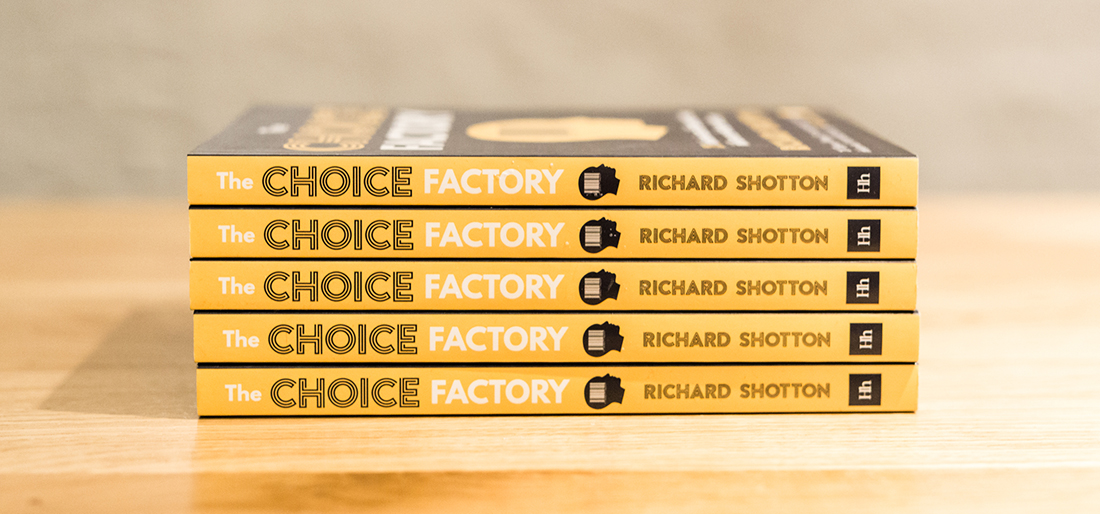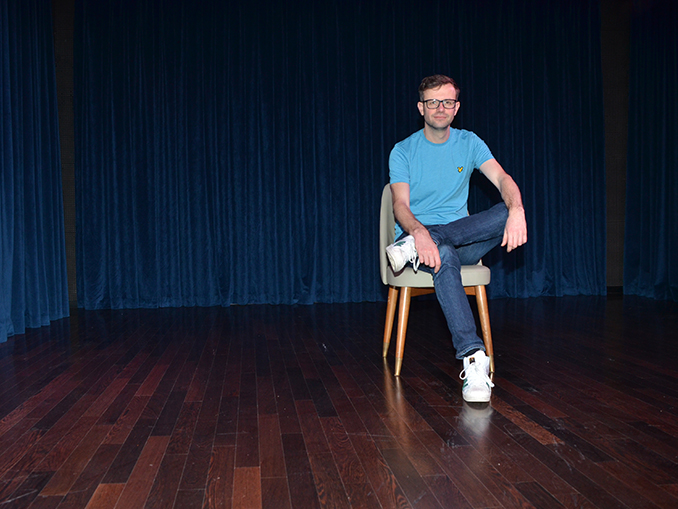Richard Shotton is considered one of the most talented brand strategists in the UK. He’s also the author of The Choice Factory: 25 Behavioral Biases That Influence What We Buy, which looks at the psychological factors that weigh into the decisions people make in their everyday lives. His book won BBH Labs’ 2018 World Cup of Advertising Books, outperforming Ogilvy on Advertising as one of the most significant books on advertising of all time. Richard and I recently talked about the ideas in his book and why they matter to marketing. Here is an excerpt from our conversation.

Kay: In The Choice Factory, you show how our biases play into how we make decisions. What made you want to write this book?
Richard: The reason I wrote it was a slight frustration with the nature of the discussion about behavioral science and marketing. There’s lots of descriptions of the biases, but I felt there wasn’t enough talk about how you apply them. The key for marketers is what do we do differently, now that we know about all these biases and cycles of experiments? I felt a lot of the conversation was about the same handful of biases, often those inspired by behavioral economics. Actually, there’s this wonderful range of hundreds and hundreds of experiments that are just as relevant but weren’t being discussed. There’s too much conversation about loss aversion and anchoring, and not enough about ideas like the “pratfall effect”—the idea that people who admit a flaw become more appealing.
The other reason is I wanted to show people that this was a very relevant topic to marketing. Every marketer should be interested in behavioral science because it gets at the very core of what we are trying to do. If you’re trying to get people to buy your brand more regularly, pay a premium, or switch from a competitor, all of that is behavior change. So why wouldn’t you draw on 130 years of study into what makes the most effective behavior change? That was the core reason I thought this was such a relevant topic.
Why those 25 (behavioral biases)? They were the ones I thought had a bearing on marketing, especially the ones where I had done some research. So, I’d re-run some classic experiments to show that the cycle of (behavioral science) experiments in the 1890s and 1960s were still relevant today, and they were still relevant for commercial brands. So that was another factor.
Kay: As I was reading through the biases in your book, I remember thinking, he’s really talking about how to leverage common sense about human nature.
Richard: On the common sense one, I think there were some biases that fit with our expectations. Social proof, the idea that consumers or decision-makers are influenced by what others do rather than just their own discrete individual motivations. That is a broadly accepted idea and wouldn’t shock too many people. But there are still lots of nuances around it that aren’t being exploited that are still worth looking at. Say, for example, social proof can be more powerful when people are scared than when they are romantically inclined, or when you tailor it to a particular group.
Where it gets really interesting is when behavioral science introduces more counterintuitive ideas, stuff that probably wouldn’t work out without this as a stimulus. And then I think you come into lovely ideas like the pratfall effect. that’s something that often runs against our common sense or our gut feelings.
Kay: Many of the biases you highlight involve reaching people who are in a certain emotional or mental context, such as when we’re in a good mood or distracted by other information. When you’re trying to get a message across, how much should you consider the user’s context?
Richard: There’s an idea in psychology called the “fundamental attribution error.” It’s the idea that people tend to overemphasize the importance of consistent factors like personality—who the person is—and underestimate factors like the fleeting parts of the context. All the marketers I’ve ever worked with always give us a target audience. But I can count on one hand the number of times someone’s given us a target context. I think we are making a mistake here, and we should be giving as much time, energy, and effort to understanding what context our message will work best as we spend on thinking about who we should target.
Mood is a fascinating one. And this is based on work by Fred Bronner. If people are in a good mood or relaxed, they’re more likely to remember ads. Laura Maclean and I did some work where we showed that relaxed people are more likely to remember ads and interpret them positively. You got a double benefit. However, it’s a much smaller group of people who are considering the mood moment as a targeting metric. Maybe because currently the way to do that is slightly crude—let’s reach people when they are in their leisure time rather than when they’re commuting, when they’re watching feel-good films on Friday and Saturday nights. Jeff Jenkins showed that you can predict someone’s mood by the movement of their mouths. If they’re moving their mouths smoothly, they tend to be relaxed and in a good mood. If they’re moving their mouths in a very jagged manner, it shows that they’re stressed. Some of those signals which allow us to target people by their mood are coming along soon, so that will be an interesting one to monitor.
Kay: A person’s context can also be their stage of life. You describe the “nine-enders” phenomenon and how people whose age ends in nine are primed for major changes in their status quo, so it’s a great time to target them with certain types of messages.
Richard: Yes, Adam Alter and Hal Hershfield came up with this. I’ve always liked this idea because I didn’t quite believe it at first. I thought there was a bit of hokum going on. People whose age ends in “nine” are much more likely to make big lifestyle changes. They looked at a huge global survey—the World Value Survey—at answers to a question along the lines of “Have you made a big lifestyle change in the last twelve months?” And people whose age ends in “nine”—nine-enders, so 39, 49, 59—are much more likely to agree that yes, they’ve made a big lifestyle change in the last few months.
But then they take a wonderfully creative approach to see actual behavior. They look at three datasets. They look at athletes and show that people who run a marathon for the first time are four times more likely to be nine-enders than other ages. They look at the affairs website—Ashley Madison—and show that of the eight million male users of that site, they’re about eight times more likely to join when their age ends in nine. They even look at American suicide data and show there was a small but statistically significant uplift in suicides when someone’s age ends in nine. That’s some very strong compelling evidence.
They essentially argue that our culture does not give equal importance to all ages or times, and when we approach the turn of a decade, that’s given disproportionate importance, disproportionate cultural significance. So as people approach that (milestone), many of them think about how their lives are going. There’s a large enough proportion who think there’s a problem with their life and therefore make a big dramatic change that we can see on an aggregate level. For marketers this isn’t just an abstract academic finding. It’s very easy to target people tightly at that moment. Facebook or whatever have all that type of data.
So, if you’re trying to stop people from smoking or encourage them to join your gym or you work for a diet brand or a big luxury holiday or a sports car brand, this is a moment that you might not have considered when the audience is particularly open to your products. This is an undervalued group of people, so you can get a bargain in terms of the media buying. Whereas, if you have the same formulaic target audience that everyone else wants—for example women 16-34—those people are highly expensive.
Kay: You explore several biases related to product positioning, such as how by changing the comparison set you can make your product look like a better value.
Richard: Rory Sutherland has done very interesting work on price relativity, which is one of the most fascinating and powerful biases that there is. Consumers have no real fixed conception of what is a good or a bad value. No one is going around the shops thinking they’re prepared to pay £1 per unit of happiness whether it’s for a can of Coke, a trainer, or a mobile phone. People have so many decisions to make each day and they don’t want to make ludicrously complex calculations that concern purchases. What they do—and I think this is true in many areas of life—they replace a complex calculation with a simpler calculation that is almost as effective. The simple calculation is, how much did I pay for something similar in the past? If I’m being asked to pay more now, this new thing is a bad value, and if I’m being asked to pay less, this new thing is good value. That should interest marketers because it means value is not an absolute thing, it’s a relative thing. How much people are prepared to pay for your brand depends on the comparison set. If you can change the comparison set, you can change willingness to pay by orders of magnitude.
So, the Red Bull example would be if they had designed the 330ml can, as most soft drinks had done up until then. The natural comparison is Coca-Cola, and that means you’ve got a pretty fixed price range that people are prepared to pay. Perversely or paradoxically, by shrinking the can to 250ml and making it much thinner, longer and quite distinct and silver, made it different looking from all the soft drinks up until then. They broke the link with the soft drink comparison set. Suddenly the price people are prepared to pay becomes free-floating. They charge a much higher price now than they would’ve been able to.
You could argue Nespresso has done the same thing. By selling it in pods, instead of half-kilo bags on the shelves of big supermarkets where their competitive set would be other roasted ground coffees, they broke the competitive set. They’ve changed the competitive set to Starbucks. People are now prepared to pay far more. They know a cup of Starbucks costs them £3, so being asked to pay 50 pence for a pod, that looks like an amazingly good value. But if you turned that per-gram price into a half-kilo bag, a kilo bag of Nespresso would cost you £60 (about $80). And there is no way on earth anyone would go into a shop, purchase a £10 bag of coffee and take home a £60 bag of Nespresso. But by shifting the comparison set, they’ve turned what would be an astronomical price into what seems like a bargain.
Kay: This shift in package design is so simple but it works brilliantly for both products. Thank you so much for talking with me!
Richard: Thank you very much. I’m glad it was useful.
Note: Richard has developed an online course on applying behavioral science to advertising: https://www.42courses.com/courses/behavioural-science-for-brands VIEWS readers can use code rs10 to receive a 10% discount, bringing the price down to £72.


Be the first to comment